Barbara Yates Beasley went to a class for animal portraits and found her niche. She now does commission work for clients creating brightly colored animal fiber art pieces. Her favorite part? Creating realistic eyes!

How did you get started designing quilts representing animals? Always an artist, or was there a “moment”?
I was happily creating other fiber art, mainly needlepoint, when I was gifted a class for animal portraits in fabric by my friend. I had turned down the opportunity when first asked because I didn’t want to quilt. That word recalled the bed quilts I helped my mom hand stitch when I was a child and into my teens. I didn’t want to do that again. I vividly remembered the sore fingers and calluses.
When was the first time that you remember realizing that you are a creative person?
I loved crayons and Big Chief paper pads. I loved creating towns and villages in mud and sticks. In my pre-teens and teens, I would gather supplies, put them in my daypack and wander the hillsides painting and drawing. Little did I know I was following the ways of the Plein Air painters. I wish I had kept some of those early pieces.
As an Amazon Associate I earn from qualifying purchases. Read more about our affiliate linking policy.

What do you do differently? What is your signature that makes your work stand out as yours?
I think it would have to be the use of bright crazy colors in pieces that still have a nod to realism. The eyes are also a signature part of my work. Often the first comment I get is how realistic, lively, and expressive the eyes are.
Where do you find your inspiration for your designs?
At least half of my work the last few years has been commissions for clients. They provide a photo or many depending on the subject. For my own work I generally use my own photos taken at various venues or I get permission to use other photographer’s photos.

Do you plan your work out ahead of time, or do you just dive in with your materials and start playing?
I start with a line drawing delineating the various values that make up the image. Planning beyond that is minimal. It depends on the animal and what they need.

How do you manage your creative time? Do you schedule start and stop times? Or work only when inspired?
I have a sign by the home studio entrance stating my office hours are 8-4 Monday-Friday or by appointment. I don’t stick to those hours as much as I used to. If I’m working at my Lyons Lair studio my hours are 9:30-5:00. The same hours the Lyons Quilting store is open. There are always days when errands take priority and days when I go up to the home studio after dinner and work until I can’t keep my eyes open.
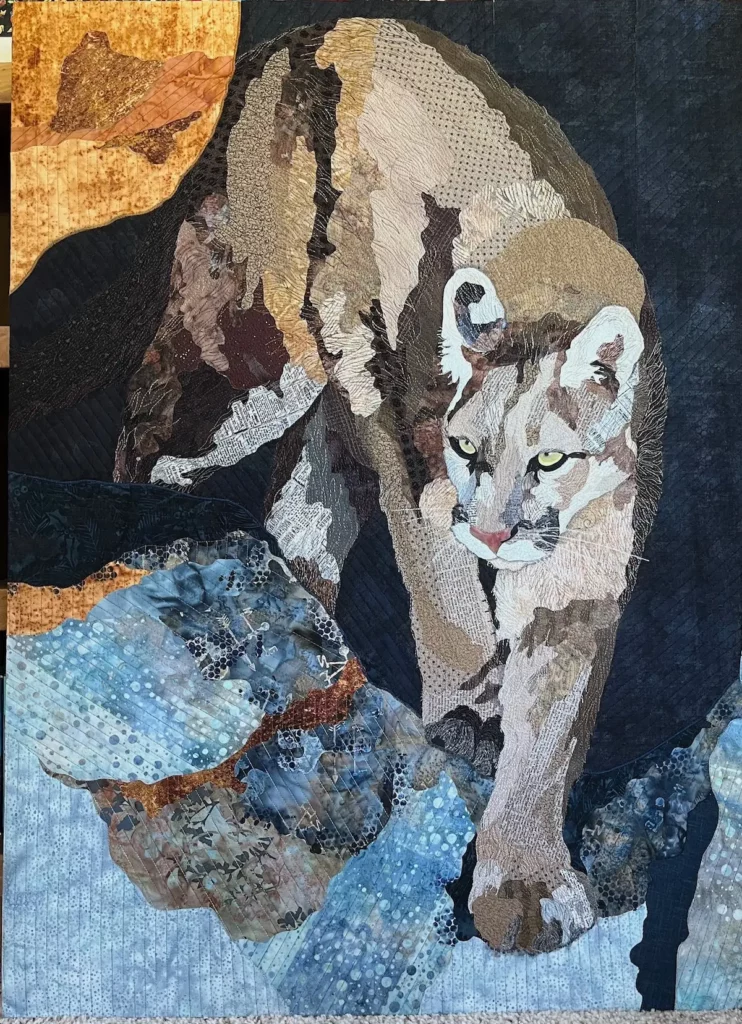
Are you a “finisher”? How many UFOs do you think you have?
My animal portraits are worked on until completed. Usually, I work on one at a time. I do have a large 20” x 40” mountain lion that I’ve been wrestling with quilting for a few months. I have been going through the stash and pulling out fabric I don’t think will ever fit in an animal and have been making traditional scrappy quilts. I put them together as fill ins between portraits or as needed. Then I quickly send them off to the long arm quilter. Nothing sits in my studio for long without being worked on. I guess that makes me a finisher with no UFOs to speak of.
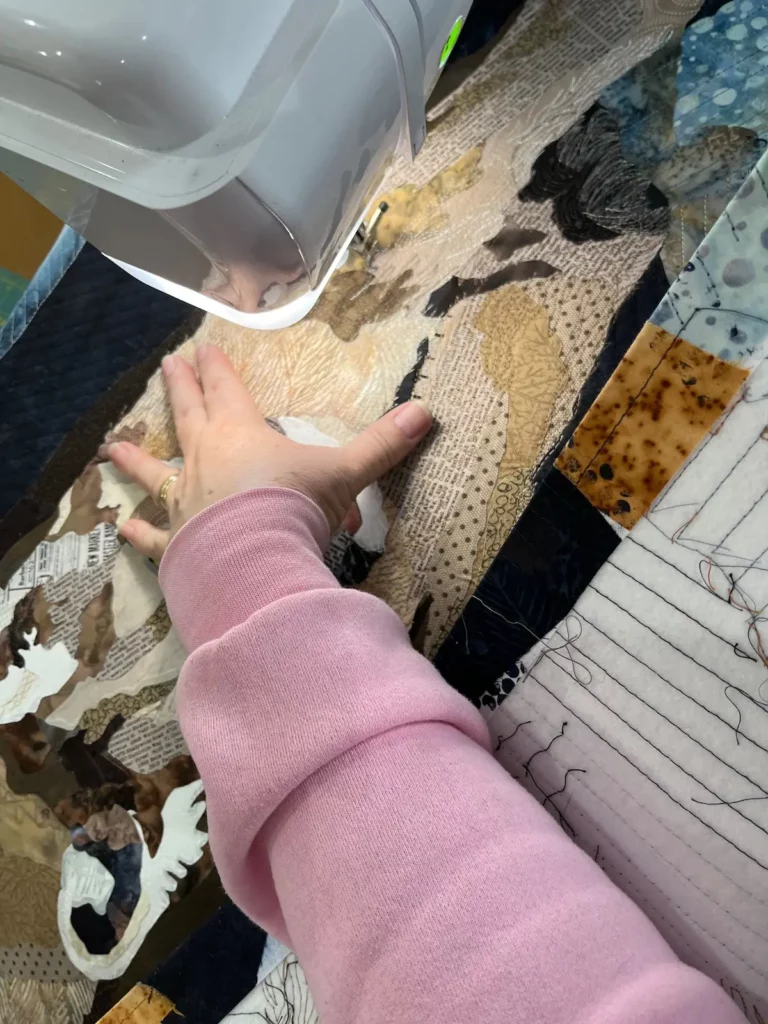
Do you have a dedicated space for creating? If so, what does it look like?
I am very lucky that I have two dedicated studio spaces. The first is in my home. We renovated our house in 2005 and added a studio space, BYB Studio, that is half of our upstairs. I have a large table made from two recycled closet doors saved from the renovation, a design wall, an 8-foot floor to ceiling bookcase dedicated to storage of fabric and stuff.


A storage closet with paints and other art materials and it holds my reference library. I also have a drafting table for painting and a seating area with a love seat and a chair my dog has claimed as hers. I use this space for actual stitching of the portraits, painting, and creating in other mediums.


My other studio, Lyons Lair Studio, is upstairs at Lyons Quilting in Lyons, CO. This is a much smaller space, a bedroom really, it is dedicated to creating the animal portraits and getting them ready to stitch. I have a 4 x8 foot design wall, two tall bookcases filled with fabric and Ikea tables for working at. I like that most of the time this space is neat and less cluttered than the BYB studio at home.
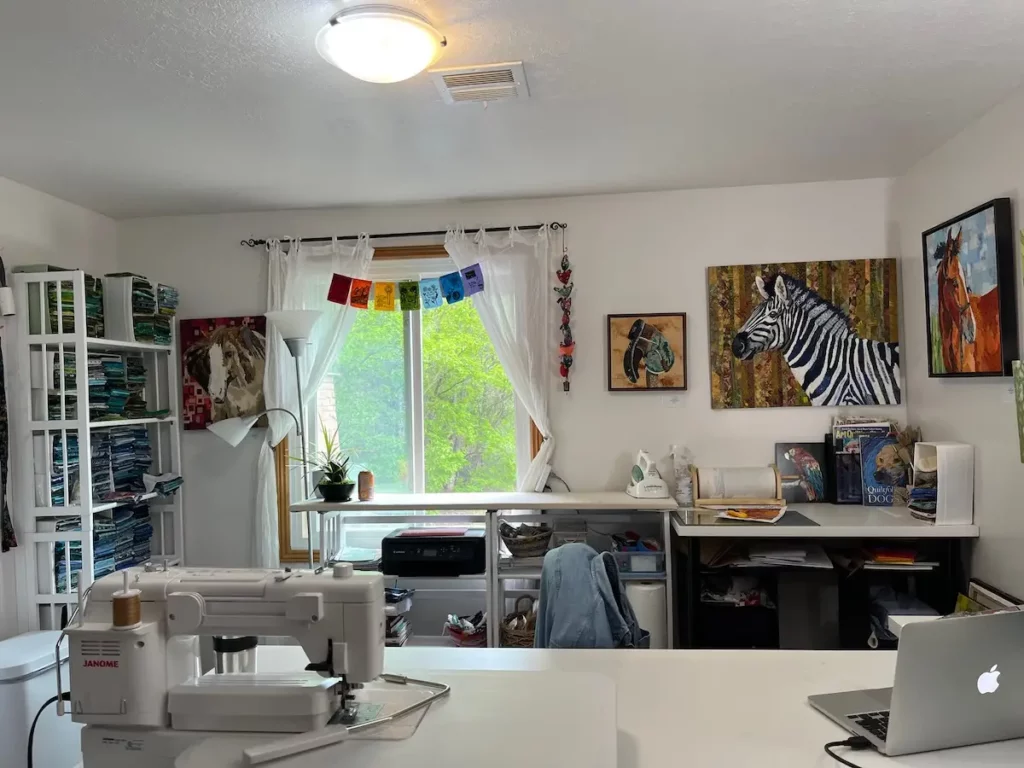
What are the indispensable tools and materials in your studio? How do they improve your work?
I love that in both studios I have a work triangle set up so that I am constantly getting up and down, sitting, standing, and walking. The more I move during the day the happier my body is. My line drawings are created on the computer, so a second large screen attached to my laptop is essential. I have been using the least expensive Wacom tablet as my input device. I recently upgraded to the Wacom One and love how easy it is to use.
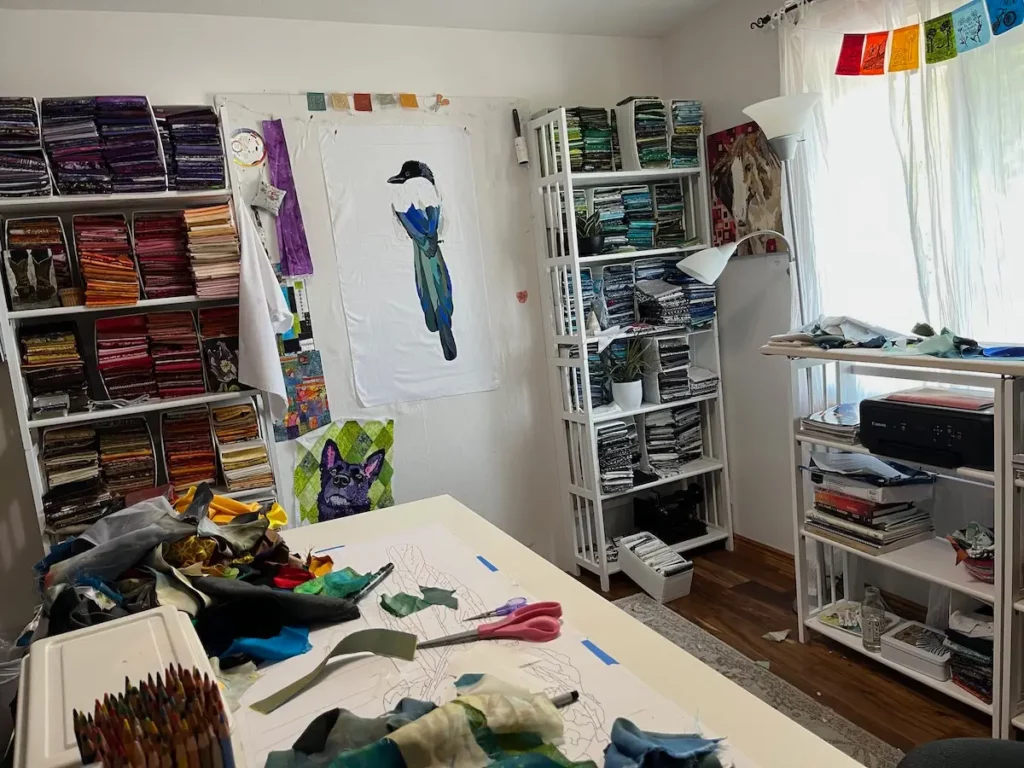
What is your favorite tip for organizing your stash of creative supplies?
Ikea Skubb folding boxes! I can’t live without them. All my fabrics are folded and neatly stacked in the boxes by color family. Most of my fabric is a fat quarter or less so this keeps everything neat and visible. I can grab a box or two if I’m looking for fabric and bring it all to my table.
My painting supplies are stored on an Ikea rolling cart. One shelf for oils, one for acrylic, the top for palette and brushes in use. I can store it in the closet when not in use or bring it out to the drafting table when I’m working.

Do you use a sketchbook or journal? How does that help your work develop?
I keep a couple of books going. One is a sketchbook to practice drawing and watercolor in, one that is for anything and everything. The third one is more of a second brain storing more written notes for projects or ongoing to do lists.
How often do you start a new project? Do you work actively on more than one project at a time?
It can vary wildly depending on my teaching, travel, and caregiving schedule. When working on a commission I allow at least a month and will only work on that. In the last six months I did 6 commissions and taught a class.

Can you tell us about the inspiration and process of one of your works? How does a new work come about?
The mountain lion that is still in process is a good example. My client chose a large wild cat as the next project. She already has a lion and leopard in her collection of my artwork. We settled on a mountain lion because she catches them often on her game cameras. I started searching for inspiration images and contacted a number of photographers before I found a couple of options I felt I could work with. I sent the images to the client, and she picked her favorite. I brought the image into Photoshop and using my Wacom drew my pattern. Although I am using the computer the pattern is still hand-drawn. The pattern is then printed out at full size.
I cut the fabrics, using a fusible as my pattern, keeping in mind that value is important. More than the actual color. Once I am happy with the animal it is fused to a backing fabric, layered, and stitched by machine.
The finished work is mounted on an artist canvas, wired, and signed, ready for delivery.
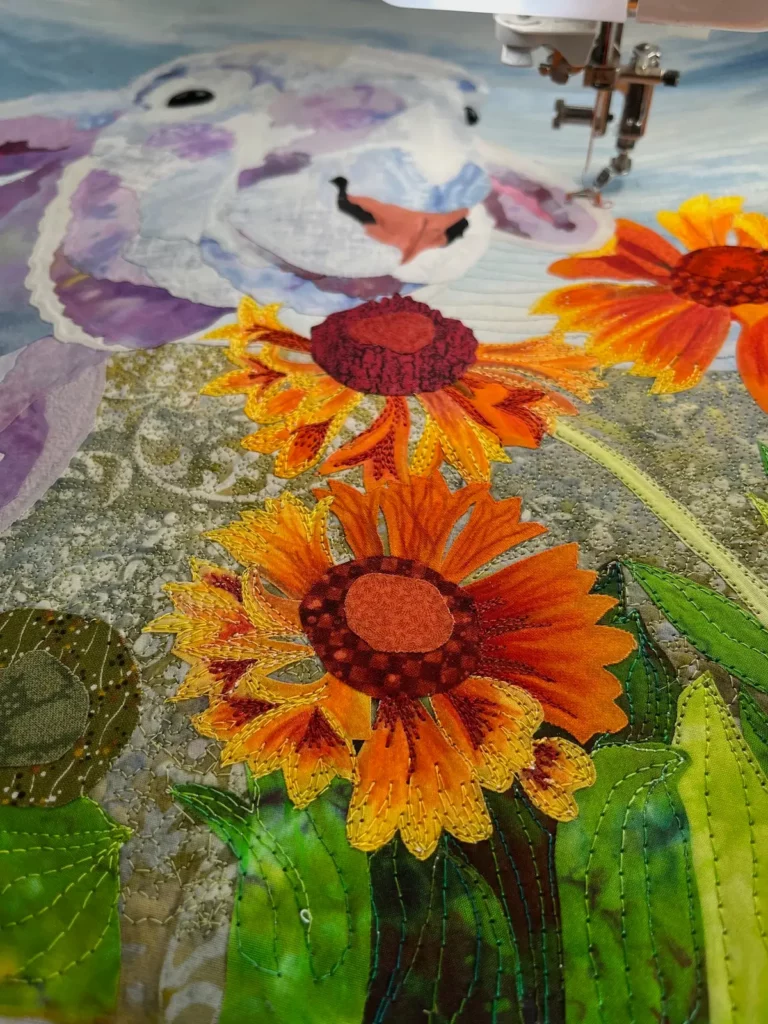
Which part of the quilt design process is your favorite?
Getting the eyes to come to life.
Which part is a challenge for you?
Sometimes when the project is larger it is a pain to maneuver under the needle of my domestic machine.

What is your favorite accomplishment?
Every time my clients are brought to happy tears.

What traits, if any, do you think that creative people have as compared to people who are not creative?
I think we all do something creative in our lives. Artists are just more open to owning and exploiting that creativity.

Do you lecture or teach workshops? How can students/organizers get in touch with you to schedule an event?
I have cut back on traveling for lectures because of caregiving. I do hold 5-day workshops at Lyons Quilting up to four times a year. I currently have 5-day workshops scheduled for March 2024 in Santa Fe with Madeline Island School of Art and October 2024 at Hudson River Valley Arts. For those workshops contact the venue directly.
I can be reached by email at: barbara@barbarayatesbeasley.com

Tell us about your blog and/or website. What do you hope people will gain by visiting?
My blog is not very active. I have been working on other writing that I hope will hit the Amazon shelves before the end of the year.
The website is: www.barbarayatesbeasley.com
On my website you can find many images of available work to purchase. Just contact me directly. There is also an archive with personal pieces that are not for sale and of course you can find links to my classes.
If you are interested in commissioning a portrait of your pet, you can find answers to many of your questions along with examples of prior commissions.
Interview posted July 2023
Browse through more inspiring interviews with collage artists on Create Whimsy.

